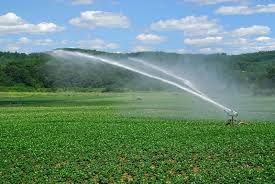
Agricultural Water Management 2 – Irrigation Water Management (IWM)
Water, once an abundant natural resource, is becoming a more valuable commodity due to droughts and overuse. Water Management is important since it helps determine future Irrigation expectations. Water management is the management of water resources under set policies and regulations.
What is Irrigation?
Irrigation is the process of watering crops, pasture, and plants by the use of water, which is supplied through pipes, sprinklers, canals, sprays, pumps and other man-made features, rather than purely relying on rainfall. In other words, it is a method of an advanced watering system for helping plants to grow because it is applied as an alternative to rain-fed farming. It is also a technique of fulfilling plant or crop water requirements as they need it as an essential resource for growth. At the same time, it aids in providing plants with the nutrients required for development and growth, as well as achieving high yields by enabling the penetration of roots in the dry fields.Types of Irrigation
There are several types of irrigation. They are based on how water is supplied to plants according to the climate, soil, or surface area. Irrigation understands the amount of water needed by the plant that is not too low or not too high. According to different needs, there are many types of irrigation:- Surface irrigation
- Drip Irrigation
- Sprinkler irrigation
- Micro-irrigation
- Water wheel irrigation
- Lawn sprinkler irrigation
- Sub-irrigation
What is Irrigation Water Management?
Irrigation water management (IWM) is the act of timing and regulating irrigation water application in a way that will satisfy the water requirement of the crop without wasting water, energy, and plant nutrients or degrading the soil resource. This involves applying water according to crop needs in amounts that can be held in the soil and at rates consistent with the intake characteristics of the soil.Objectives of Irrigation Water Management
A primary objective in the field of irrigation water management is to give irrigators an understanding of conservation irrigation principles. This is done by showing them how they can judge the effectiveness of their own irrigation practices, make good water management decisions, or recognize the need to make adjustments in existing systems or to install new systems. The net result of proper irrigation water management typically:- Prevents excessive use of water
- Minimizes pumping costs
- Prevents excessive soil erosion
- Reduces labor
- Maintains or improves quality of groundwater and downstream surface water
- Increases crop biomass yield and product quality
Irrigation water management concepts
1. Concept of irrigation water management
The simplest and basic irrigation water management tool is the equation: Q T = D A where: Q = flow rate (ft3/s) T = time (hr) D = depth (in) A = area (acres) For example, a flow rate of 1 cubic foot per second for 1 hour = 1-inch depth over 1 acre. This simple equation, modified by an overall irrigation efficiency, can be used to calculate daily water supply needs by plants, number of acres irrigable from a source, or the time required to apply a given depth of water from an irrigation well or diversion. Typically, over 80 percent of IWM concerns can be at least partly clarified by the application of this equation. Water should be applied at a rate or quantity and in such a manner to have sufficient soil-water storage, be nonerosive, have minimal waste, and be non - degrading to public water quality. Irrigations are timed to replace the planned depleted soil moisture used by the crop. Effective rainfall during the growing season should be taken into consideration.2. When to irrigate
When to irrigate is dependent on the crop water use rate, sometimes referred to as irrigation frequency. This rate can be determined by calculation of Estimated Crop Evapotranspiration (ETc) rate for specific crop stage of growth, monitoring plant moisture stress levels, monitoring soil-water depletion, or a combination if these. Too frequently, crop condition is observed to determine when to irrigate. When plants show stress from lack of moisture, it is typically too late. Generally, crop yield and product quality have already been adversely affected. The over-stress appearance may also be from shallow roots resulting from over - irrigation or from disease, insect damage, or lack of trace elements. Certain plants can be excessively stressed during parts of their growth stage and have little effect on yield.3. Rainfall management
In moderate to high rainfall areas, managing the timing of irrigations to allow effective use of rainfall during the irrigation season is a common practice. The irrigation decision maker can attempt to predict rainfall events and amounts (which too often does not work), or the depleted soil water is never fully replaced with each irrigation. Instead, between 0.5 and 1.0 inch of available water capacity in the soil profile can be left unfilled for storage of potential rainfall. Rainfall probability during a specific crop growing period and the level of risk to be taken must be carefully considered by the irrigation decisionmaker. Applied irrigation water should always be considered supplemental to rainfall events.4. Water supply limitations
Where water supply is limiting, deficit or partial year irrigation is often practiced. Partial irrigation works well with lower value field crops. It does not work well with high value crops where quality determines market price, especially the fresh vegetable and fruit market. Typically, water is applied at times of critical plant stress or until the water is no longer available for the season. Yields are generally reduced from their potential, but net benefit to the farmer may be highest, especially when using high cost water or a declining water source, such as pumping from a declining aquifer. An economic evaluation may be beneficial.5. Water delivery
Water supply and delivery schedules are key to proper irrigation water management. When water users pump from a well or an adjacent stream or maintain a diversion or storage reservoir, they control their own delivery. In some areas, delivery is controlled by an irrigation district or company. Where water supplies are not limited and delivery is in open canal systems, irrigation districts often carry from 10 to 30 percent additional water through the system as management water to reduce district water management requirements. Low cost semi or fully automated controllers are available for water control structures that accomplish the same purpose with less water.6. Water measurement
A key factor in proper irrigation water management is knowing how much water is available to apply or is applied to a field through an irrigation application system. Many devices are available to measure open channel or pipeline flows. Too many irrigators consider water measurement a regulation issue and an inconvenience. The importance of flow measurement for proper irrigation water management cannot be overstressed. Typically, less water is used where adequate flow measurement is a part of the water delivery system and a unit cost billing mechanism is used.Conclusion
Water is of fundamental importance to human development, the environment and the economy. Access to water and water security is paramount to improving food security, incomes and livelihoods of rural communities. Reliable access to water remains a major constraint for millions of poor farmers, mostly those in rainfed areas, but also those involved in irrigated agriculture. Climate change and the resulting changing rainfall patterns pose a threat to many more farmers, who risk losing water security and slipping back into the poverty trap. Agricultural water management includes the management of water used in crop production (both rainfed and irrigated), livestock production and inland fisheries. Improved agricultural water management in these production areas is the answer to both global food security and poverty reduction. Current food production must be doubled in order to meet the food needs of the world by 2050; this increase must come from areas presently utilizing rainfed agriculture, as well as from the expansion and improvement of existing irrigated agriculture.References
- Christine Nesblit: Scaling up results in agricultural water management. IFAD
- Irrigation water management. http://www.irrigationtoolbox.com/NEH/Part652_NationalIrrigationGuide/ch9.pdf.
- Kelly J. Klausmeyer: Irrigation water management. Natural Resources Conservation Service (NRCS), Hays, Kansas.
- MDM Landscapes (2022): Why is irrigation water management important?
- Prasanna (2022): Irrigation Advantages and Disadvantages | Types of Irrigation | Pros and Cons | Benefits and Drawbacks of Irrigation.
Recent Posts
Editor0 Comments
Does Guava Cause Appendicitis?
Editor0 Comments
Heat stress to threaten over 70% of global agriculture by 2045
Tags
africa
agribusiness
agriculture
animal feed
antimicrobial resistance
aquaculture
banana
biofloc tecnology
bird flu
brazil
cassava
cattle
China
climate change
compost
corn
FAO
germany
GMO
gmo corn
greenhouse
hens
IITA
india
kenya
maize
malaysia
mexico
namibia
Nanotechnology
nigeria
palm oil
pork
postharvest losses
potato
rice
rodents
soil
uganda
US
USDA
vertical farming
wheat
world food programme
Yemen



